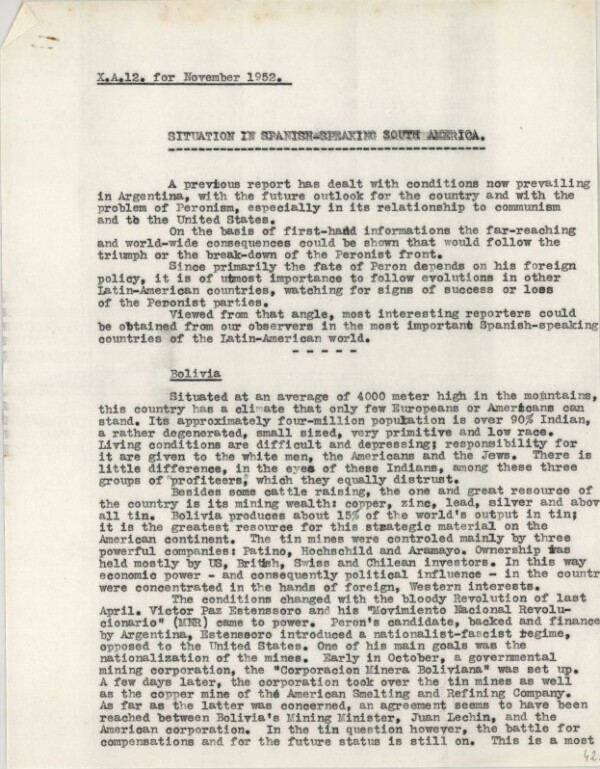
Stranica 1 [1]

OCR
XeAel2e for November 19529. SITUATION IN SPAWISH@SPRAKING SOUTH AMERICA. A previous report has dealt with conditions now prevailing in Argentina, with the future outlook for the country and with the problem of Peronism, especially in its relationship to communism and tb the United States. On the basis of first-hand informations the far-reaching and world-wide consequences could be shown that would follow the triumph or the break-down of the Peronist front. Since primarily the fate of Peron depends on his foreign policy, it is of utmost importance to follow evolutions in other Iatin-American countries, watching for signs of success or loss of the Pernonist parties. Viewed from that angle, most interesting reporters could be obtained from our observers in the most important Spanish-speaking countries of the Latin-American world. Bolivia Situated at an average of 4000 meter high in the mountains, this country has a climate that only few Europeans or Amertcans can stand. Its approximately four-million popukation is over 90% Indian, a rather degenerated, small sized, very primitive and low races Living conditions are difficult and depressing; responsibility for it are given to the white men, the Americans and the Jews, There is little difference, in the eyes of these Indians, among these three groups of "profiteers, which they equally distrust. Besides some cattle raising, the one and great resource of the country is its mining wealth: copper, zine, lead, silver and abov all tine Bolivia produces about 15% of the world's output in tin; it is the greatest resource for this strategic material on the American continent. The tin mines were controled mainly by three powerful companies: Patino, Hochschild and Aramayo. Ownership was held mostly by US, British, Swiss and Chilean investors. In this way economic power - and consequently political influence = in the countr were concentrated in the hands of foreign, Western interests. The conditions changed with the bloody Revolution of last April. Victor Paz Estenssoro and his "Movimiento Nacional Revolucionario” (MNR) came to powers Peron's candidate, backed and finance by Argentina, Estenssoro introduced a nationalist-fascist begime, opposed to the United States. One of his main goals was the nationalization of the mines, Early in October, a governmental mining corporation, the “Corporacion Minera Boliviana" was set upe A few days later, the corporation took over the tin mines as well as the copper mine of thé American Smelting and Refining Company. As far as the latter was concerned, an agreement seems to have been reached between Bolivia's Mining Minister, Juan Lechin, and the American corporatione In the tin question however, the battle for compensations and for the future status is still on. This is a most U2.
Strukturalno
Custom
Image Metadata
- Širina slike
- 2492 px
- Visina slike
- 3195 px
- Rezolucija slike
- 300 px/inch
- Veličina originalnog fajla
- 1.99 MB
- Permalink ka JPG-u
- ho6_000087/0000.jpg
- Permalink ka OCR-u
- ho6_000087/0000.ocr